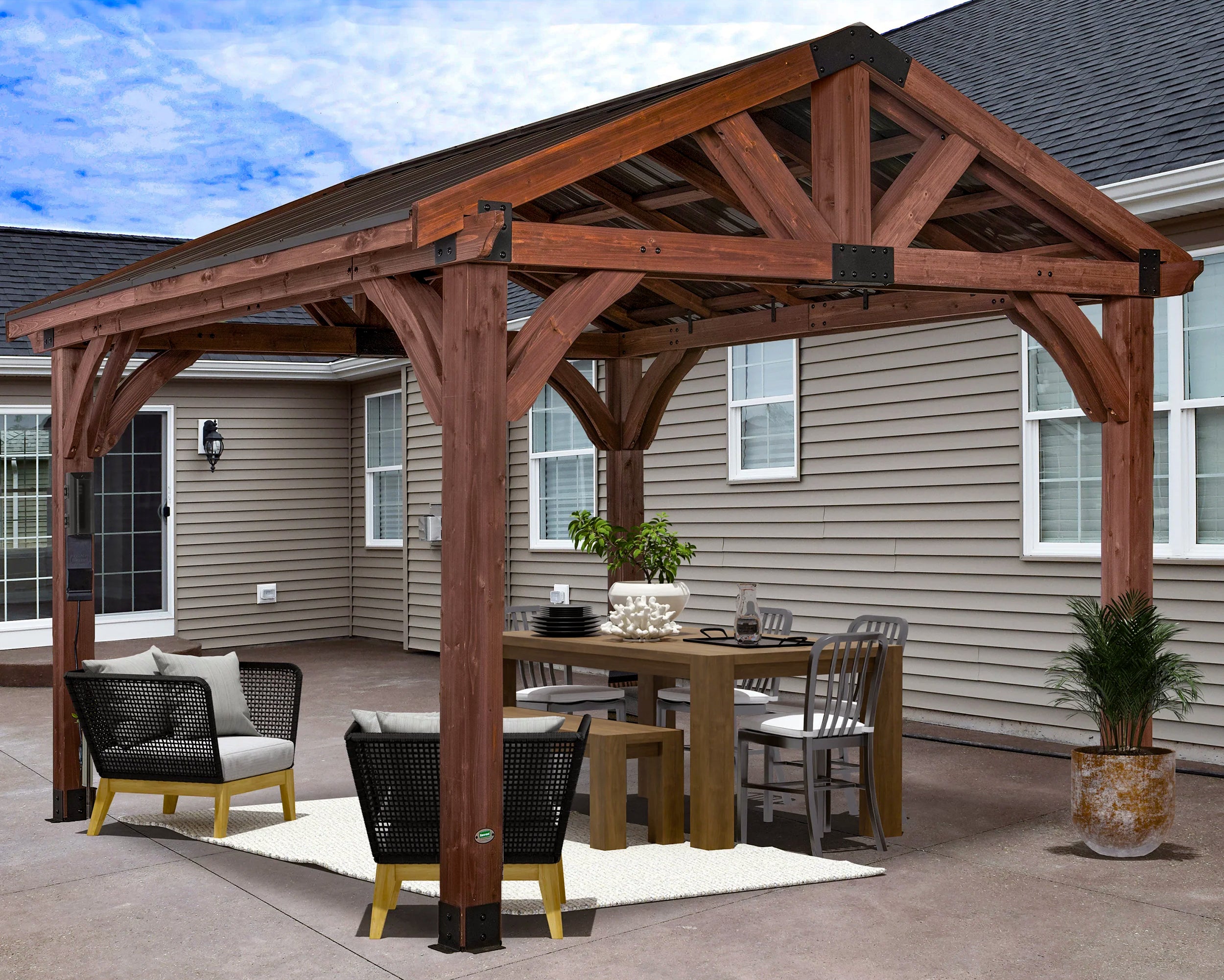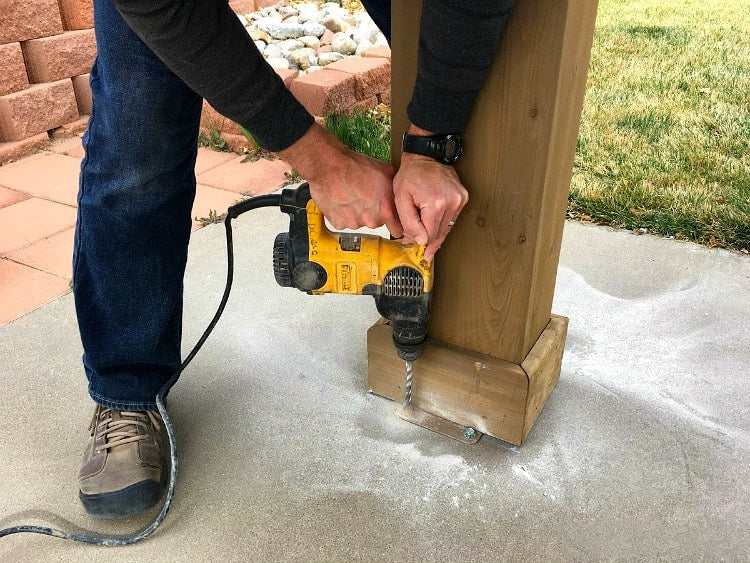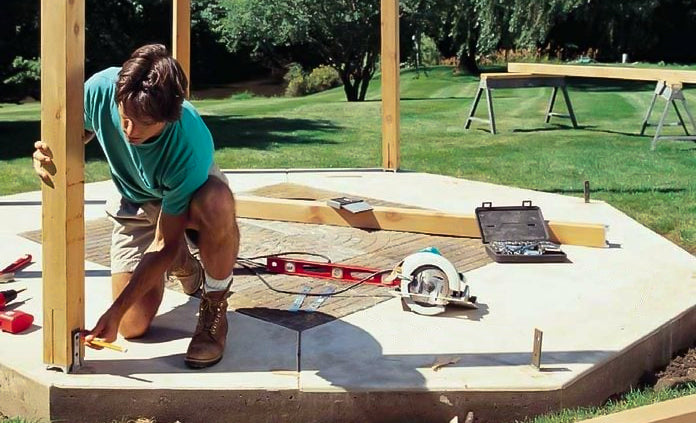Call us at 725-239-9966!
M-F: 8 AM-7 PM PST
Call us at 725-239-9966!
M-F: 8 AM-7 PM PST

Adding a backyard gazebo is a big investment, so you’ll want to make sure it is properly secured in place on your concrete surface. One of the best methods for anchoring a gazebo is to attach it firmly to a concrete slab without drilling. Concrete provides a sturdy, stable base for gazebo anchoring. With the right techniques and materials, you can securely anchor your gazebo to concrete without damaging the surface.
In this comprehensive guide, we’ll outline the complete process for how to anchor a gazebo to concrete without drilling holes. Follow these steps, and you’ll be able to fix your gazebo in place to withstand wind, rain, and regular use without budging over time.

Concrete provides a rigid, stable base for securely anchoring a gazebo without drilling holes.
Use wedge anchors, eye bolts, cables, and turnbuckles to firmly fix a gazebo to a concrete slab.
Properly preparing the surface and using the right hardware are crucial for maximum stability.
Allow cables some slack to handle wind gusts and check connections routinely.
Before anchoring - remember to think about the function just like we mention in all online sources. Expert Tips for Building a Backyard Gazebo | Redfin
Before going over the installation process, let's first look at why concrete is such a good option for anchoring a gazebo:
Stability - Concrete is extremely rigid and heavy. When anchored properly without drilling, a gazebo attached to concrete will be very difficult to shift or sway. This prevents the structure from rocking in windy conditions.
Security - With the right anchoring system, a gazebo can be secured tightly to concrete. This deters potential theft of the structure.
Longevity - A concrete base lasts for decades. When the legs of the gazebo are anchored to concrete, you won't have to worry about replacing rotten or degraded mounting surfaces.
Customization - Concrete can be poured and formed into whatever shape or configuration fits your patio space. This allows flexibility in gazebo placement. If you need to build or purchase a detached garage to house the gazebo, be sure to check out our buyers guide for choosing the right one.
Appearance - A concrete pad nicely complements a gazebo aesthetically, especially with patterns or color coatings applied to the surface.
Overall, concrete provides the ideal substrate to keep your gazebo firmly in place for years using anchors without drilling holes. The rest of this guide will show you how to properly set up this type of anchoring system.
To complete this gazebo anchoring project, you will need:
Anchoring Hardware:
Tools:
Other Supplies:
This list covers all the equipment, hardware, and accessories you will need for a typical 10x12 wood top gazebo to be securely anchored to the concrete without drilling. For especially large or heavy-duty gazebos, extra anchors and thicker cables can be used to secure a gazebo for maximum stability.

Follow this complete guide to properly anchor your gazebo to concrete without needing to drill:
Before installing anchors, take time to properly prepare the concrete:
Sweep away any debris from the concrete patio slab using a broom. Use a hose if needed.
Mix up a solution of TSP cleaner and warm water in a bucket. Scrub down the entire slab area where your gazebo will be located using a stiff brush.
Rinse thoroughly to remove all residue. Allow the concrete to dry completely.
Check for levelness using a 4-foot level in all directions. Adjust cable lengths later to account for any medium unevenness.
Use a marker to indicate the positions where each anchor will be installed. Measure carefully from the gazebo legs.
Proper surface cleaning and preparation ensures the anchors bond tightly to the concrete.
With the surface prepped, install the anchors without drilling:
Drill guide holes in the marked anchor locations using a masonry bit. Follow the specifications for your chosen wedge anchor size.
Thoroughly clean each hole using a wire brush to remove all concrete dust.
Gently tap the wedge anchors into the holes using a hammer until the head is countersunk in the concrete. Avoid cracking the surface.
Tighten the nut on each anchor by hand first, then fully tighten using a wrench according to the torque recommendations.
The wedge design allows the anchors to be tapped into the concrete holes and locked tightly in place without passing all the way through the slab.
With the anchors fully seated, add the eye bolts:
Screw an eye bolt into each protruding concrete wedge anchor end. Use the correct diameter to match the anchors.
Use a wrench to tighten the eye bolts until completely snug.
Position each eye bolt upright facing toward where the gazebo will be located.
The eye bolts allow easy attachment of the cables from the gazebo corners at each anchoring point in the concrete.
Moving on to the gazebo itself:
Determine the optimal corner points to attach the cables, usually the outer leg brackets or roof eave joints.
Attach an open turnbuckle to each chosen gazebo cable connection point.
Run the loose cable ends through the turnbuckle openings. Add a thimble to the cable ends to prevent fraying.
Use cable clamps to crimp the ends into permanent loops.
Leave some initial slack in the cables - they'll be tightened later after anchoring to the concrete.
The final step is securing the system:
Feed each cable through the corresponding eye bolt in the concrete.
Slowly tighten the turnbuckles until all slack is removed from the cables.
Continue tightening until the gazebo is held firmly when rocked from corner to corner.
Use cable clamps to lock the turnbuckles in place so they don't loosen.
Tuck away any excess cable through the turnbuckles.
The gazebo is now anchored securely! Leave a little cable play to allow the structure to sway slightly in wind gusts.

To ensure your anchored gazebo stays securely in place for years:
Check the connections at the eye bolts and turnbuckles periodically. Tighten any loose parts.
Consider extra anchors and thicker cables for large or heavy-duty gazebos. More connection points add stability.
Face the open side of the gazebo away from prevailing winds to reduce lift.
Avoid water pooling around anchors which can compromise the concrete over time.
Temporarily detach cables if needed to remove or reposition the gazebo.
Proper routine anchoring system maintenance prevents issues and ensures your gazebo remains stable for the long term.
Adding an anchored gazebo can take your concrete patio or deck to the next level. With the techniques in this guide, you can now confidently install a gazebo to the concrete without drilling into or otherwise damaging the surface.
Anchoring to concrete without drilling provides excellent stability while preserving the integrity of your slab. Follow these instructions carefully, use quality components, and verify the connections periodically to get years of enjoyment from your sheltered relaxation spot.
The best way to secure a gazebo from wind is to use anchor bolts. These can be inserted into pre-existing holes in the concrete or directly into the concrete to create a secure attachment point for the gazebo.
One way to anchor the gazebo on a patio is to use anchor bolts. First, determine the desired location for the gazebo on the patio. Next, use a marker or chalk to mark the positions where the anchor points will be. Finally, insert the anchor bolts or concrete into the holes or directly into the patio, and tighten the nuts or screws to secure the gazebo.
A smooth, level, sturdy concrete at least 4 inches thick is ideal for anchoring a gazebo without drilling. Avoid porous or crumbling concrete.
Check the tightness of all anchors, eye bolts, turnbuckles, and cable clamps. Test stability by gently rocking the gazebo. Add more anchors if needed.
For lightweight metal gazebo designs, weights may suffice, but for sturdy wood gazebos, anchoring to concrete without drilling provides superior stability.
Small variations can be managed with adjustable cable lengths. However, major unevenness will result in an unstable installation.
The anchors can be removed and holes patched if needing to relocate the gazebo. Cables can be detached seasonally as well.

{"one"=>"Select 2 or 3 items to compare", "other"=>"{{ count }} of 3 items selected"}
Comments
Leave a comment